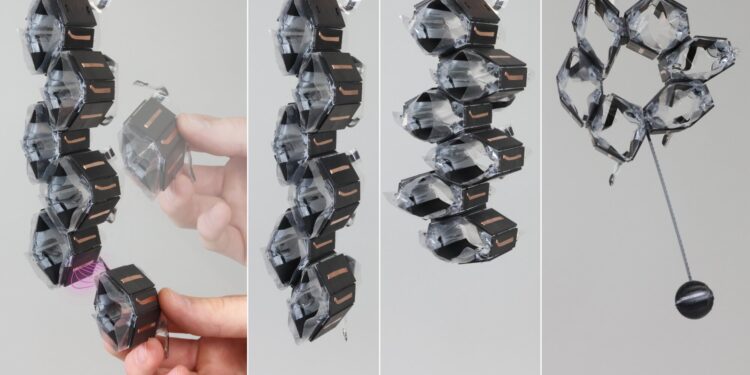HEXEL modules snap together to form a long-stroke muscle and multimodal network. Credit: Zachary Yoder / MPI-IS Ellen Rumley / MPI-IS
Scientists at the Max Planck Institute for Intelligent Systems (MPI-IS) have developed hexagonal-shaped robotic components, called modules, that can be assembled like LEGO to form high-speed robots that can be rearranged for different abilities.
The research team from the Department of Robotic Materials at MPI-IS, led by Christoph Keplinger, has integrated artificial muscles into hexagonal exoskeletons in which magnets are embedded, enabling rapid mechanical and electrical connections.
The team’s work, “Hexagonal Electrohydraulic Modules for Rapidly Reconfigurable High-Speed Robots,” was published in Scientific robotics September 18, 2024.
Six rigid, lightweight fiberglass plates serve as the exoskeleton of each HEXEL module. The internal joints of the hexagons are actuated by hydraulically amplified electrostatic self-healing artificial muscles (HASEL).
Applying high voltage to the module causes the muscle to activate, rotating the joints of the hexagon and changing its shape from long and narrow to wide and flat.
“The combination of flexible and rigid components enables high travel and speeds. By connecting multiple modules, we can create new robot geometries and reuse them to meet changing needs,” says Ellen Rumley, a visiting researcher at the University of Colorado Boulder.
She and Zachary Yoder, both doctoral students in the Department of Robotic Materials, are co-first authors of the publication.
In a video, the team demonstrates the many behaviors that can be created with HEXEL modules. A group of modules crawls through a narrow space, while a single module moves so fast it can leap into the air. Multiple modules are connected into larger structures that produce different movements depending on how the modules are attached. For example, the team combined multiple modules to create a robot that rolls quickly.
-
Individual HEXEL modules combine soft artificial muscles with rigid components for fast, wide-ranging movements. Credit: Zachary Yoder/MPI-IS Ellen Rumley/MPI-IS
-
HEXEL modules drive a robot as it rolls through sand. Credit: Zachary Yoder/MPI-IS Ellen Rumley/MPI-IS
-
A chain of HEXEL modules with Ellen Rumley on the left and Zach Yoder on the right. Credit: MPI-IS / Wolfram Scheible
-
Fast moving HEXEL module. Credit: MPI-IS / Wolfram Scheible
“In general, it makes a lot of sense to develop robots with reconfigurable capabilities. It’s a sustainable design option: instead of buying five different robots for five different uses, we can build many different robots using the same components. Robots made from reconfigurable modules could be rearranged on demand to provide more versatility than specialized systems, which could be beneficial in resource-constrained environments,” Yoder concludes.
More information:
Christoph Keplinger et al, Hexagonal electrohydraulic modules for rapidly reconfigurable high-speed robots, Scientific robotics (2024). DOI: 10.1126/scirobotics.adl3546. www.science.org/doi/10.1126/scirobotics.adl3546
Provided by the Max Planck Society
Quote:Combining soft artificial muscles with a rigid, magnetic exoskeleton to create building blocks for versatile robots (2024, September 18) retrieved September 18, 2024 from
This document is subject to copyright. Apart from any fair dealing for the purpose of private study or research, no part may be reproduced without written permission. The content is provided for informational purposes only.



